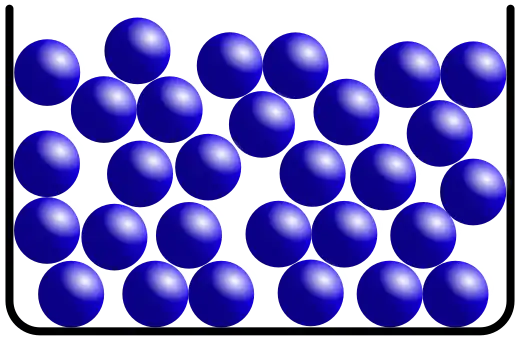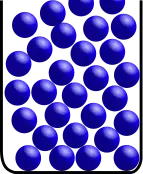< Wikijunior:Particles
This chapter, as mentioned in the previous, is about using the particle model to explain the three states of matter.
To explain the three states
| State | Model | Explanation |
|---|---|---|
| Solid |  |
In solids, the particles are cramped together tightly in regular positions, and they can only vibrate (wobble) a little, but in fixed positions. Their positions cannot change freely, as a result. |
| Liquid |  |
In liquids, the positions of particles are not fixed like in solids, but the particles cannot move as freely as those in gas, as they can only slide over one another. They are arranged irregularly. |
| Gas |  |
In gases, the positions of particles can alter easily, as the particles move at random directions very quickly. The particles are not packed tightly like those of the two states above, and are arranged irregularly. The particles can be very far apart! |
To explain the properties of each of the states
| State | Model(s) | Flexibility of shape | Compressibility |
|---|---|---|---|
| Solid |  |
Solids have a fixed shape; their shape cannot be altered. | Solids have a fixed volume; you cannot compress them. |
| Liquid | 
|
Liquids do not have fixed shapes. As you can see, the shape can alter depending on the shape of the container. | Liquids have a fixed volume. You can see from the model that there are the same number of liquid particles and that the size of the particles are the same. |
| Gas |   |
Gas particles do not have a fixed shape so you can safely bend them and they won't even break. In the model, the shape of the particles changed from the shape of a square and the shape of a triangle. | Gas particles are perfectly compressible, as opposed to the above two. That means you can press it and it will actually become smaller. Then if you put them in a really big container, it will spread all around the container, through diffusion. Note that the triangle here is a lot smaller than the square. |
Quiz
- Briefly explain, in your own words, the different properties of the three states of matter and arrangement and movement of their particles.
- Go to the library or search the Internet about 'plasma' the 'fourth' state of matter, and write about 200 words about it.
Answers will vary.
This article is issued from Wikibooks. The text is licensed under Creative Commons - Attribution - Sharealike. Additional terms may apply for the media files.
